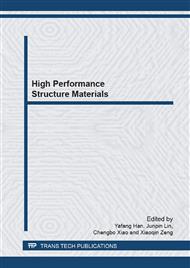p.833
p.839
p.844
p.850
p.855
p.860
p.866
p.872
p.878
Phase Transformation Behavior and Mechanical Properties of Ti-Mo-Sn Alloys
Abstract:
A series of Ti-Mo-Sn alloys with different Mo contents from 7% to 15% (wt. %) were prepared, and the effects of Mo content and thermo-mechanical treatment on their microstructural evolution and mechanical behavior were investigated. The experimental results indicated that the β to α martensite transformation can be effectively suppressed with increasing Mo content. After cold rolling treatment, superior mechanical properties and low modulus were achieved in Ti-8Mo-4Sn alloy, with tensile strength of 1108MPa, yield strength of 1003MPa and low Youngs modulus of 53GPa. The influence of severe cold deformation on the macrostructure and mechanical properties was discussed based on the characterization of X-Ray diffraction and mechanical tests. It was demonstrated that the cold rolling induced fine α martensite and high density dislocations lead to the high strength of the Ti-Mo-Sn alloys. The fine α martensite as well as the β matrix with low stability guarantee low Youngs modulus.
Info:
Periodical:
Pages:
855-859
Citation:
Online since:
February 2013
Authors:
Price:
Сopyright:
© 2013 Trans Tech Publications Ltd. All Rights Reserved
Share:
Citation:


